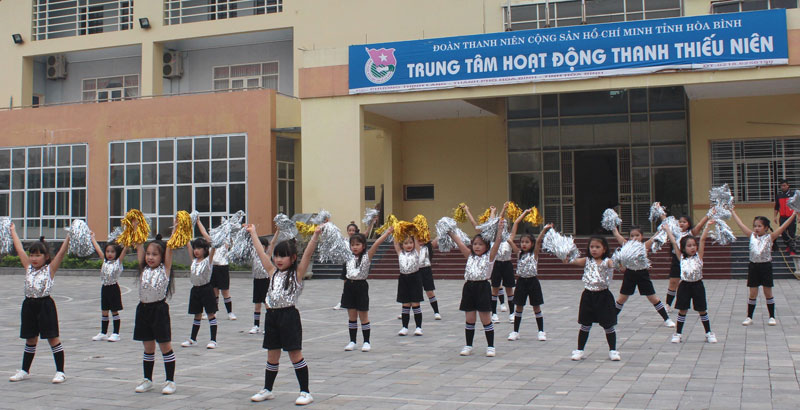
(HBO) - Zumba dance for children is now attracting the active participation of small children. Out of the fifteen clubs and gifted classes, which are being regularly maintained at the Provincial Youth Activity Center, Zumba Kid Club is considered the most outstanding club, creating a healthy and useful playground with great experiences for the children at the age of four to twelve.

Zumba dance performance in the club's picnic activities.
Pham Phuong Nhi, a pupil of class 1A2, Nguyen Tat Thanh high school (Hoa
Binh City) has joined the Zumba Kid club since she was in the 4-year-old
kindergarten class. At that time, the distance from the kindergarten to the
club is very close, so it is suitable for her schedule. Now, it takes more than
30 minutes from Nhi's primary school to the club in the school’s bus if not for
other reasons.
However, she really loves zumba dance, so Mrs. Hung, Nhi's mother has decided to allow her child to attend the club
even though the time and conditions of the transportation are not as convenient
as before. She herself has always been attached to the club's activities for
three years, so she highly appreciates the club experience that has brought to
the children. As a result of this, every Monday, Wednesday and Friday afternoons
in nearly a year, after school, Nhi takes a bus to go straight to the club for
the extracurricular activities that has become her indispensable passion.
like Pham Phuong Nhi, more than thirty other members in Hoa Binh Zumba Club
are very passionate about zumba dance and useful experiences of the Club. In
the relaxing atmosphere and cheerful music background, the small children are
guided to continuous and stretching movements, high jumps, twists, hip shaking,
belly sticks, hand-foot-head
coordination with zumba intensity which are suitable for the children to help
their bodies more supple, faster and more spiritual, after a stressful learning
day.
The People’s Committee of Lac Son district held a ceremony on April 28 to receive the provincial relic certificate for the ancient rock carving site at Suoi Co stream, located in My Thanh commune.
A special music show titled "The country is in the fullness of joy” has been held at Hoa Binh Square in Hoa Binh city in celebration of the 50th anniversary of the liberation of the South and national reunification (April 30, 1975–2025).
The People's Committee of Lo Son commune, Tan Lac district, has organised the local annual traditional stream fishing festival on April 19 - 20.
As a land deeply intertwined with human history and Vietnam’s millennia-long journey of nation-building and defence, Hoa Binh is often revered for its epic tales and legends.
Residents of Hoa Binh boast a rich cultural identity, reflected in their unique language, traditional attire, customs, and folk melodies – described as "sweet as honey, clear as a mountain stream.”
Lac Son district’s Vu ban town held the 2025 Truong Kha temple festival on April 12–13 (the 15th–16th days of the third lunar month). Since its revival in 2019, the festival has been organised every three years, preserving valuable intangible heritage while meeting the community’s cultural and spiritual needs.



